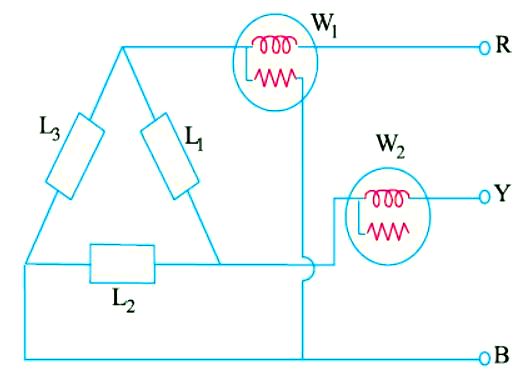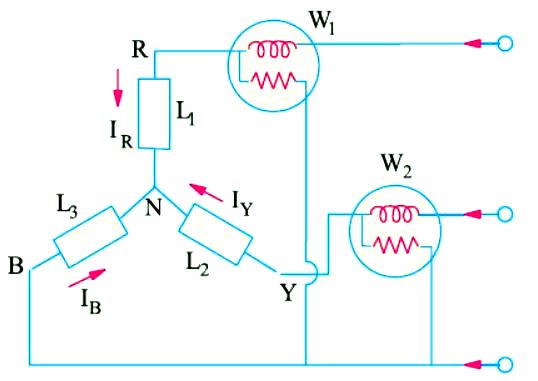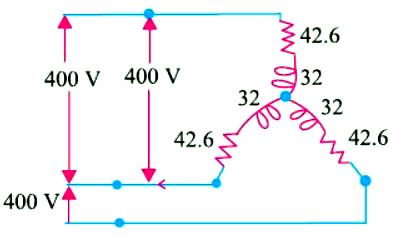Power Measurement Two Wattmeter Method
Power Measurement Two Wattmeter Method
As shown in Figure (A), the current coils for Power Measurement Two Wattmeter Method are inserted in any two lines and the potential coil of each joined to the third line. It can be proved that the sum of the instantaneous powers indicated by W1 and W2 gives the instantaneous power absorbed by the three loads L1, L2 and L3. A star-connected load is considered in the following discussion although it can be equally applied to Δ-connected loads because a Δ-connected load can always be replaced by an equivalent Y-connected load.
Now, before we consider the currents through and potential difference across each wattmeter, it may be pointed out that it is important to take the direction of the voltage through the circuit the same as that taken for the current when establishing the readings of the two wattmeters.
Instantaneous current through W1= iR
p.d. across W1 = eRB = eR–eB
p.d. across power read by W1 = iR (eR–eB)
Instantaneous current through W2= iY
Instantaneous p.d. across W2 = eYB = (eY–eB)
Instantaneous power read by W2 = iY (eY–eB)

∴ W1 + W2 = eR(eR – eB) + iY(eY – eB) = iReR + iYeY − eB(iR+iY)
Now iR + iY + iB =0
iR + iY = – iB
OR W1 + W2 = iReR + iYeY + iBeB = p1 + p2 + p3
where p1 is the power absorbed by load L1, p2 that absorbed by L2 and p3 that absorbed by L3
∴ W1 + W2 = total power absorbed
The proof is true whether the load is balanced or unbalanced. If the load is Y-connected, it should have no neutral connection (i.e. 3 – φ , 3-wire connected) and if it has a neutral connection (i.e. 3– φ , 4-wire connected) then it should be exactly balanced so that in each case there is no neutral current iN otherwise Kirchoff’s current law will give
iN + iR + iY + iB = 0.
We have considered instantaneous readings, but in fact, the moving system of the wattmeter, due to its inertia, cannot quickly follow the variations taking place in a cycle, hence it indicates the average power.
AdBlock-2

Two Wattmeter Method – Balanced Load
If the load is balanced, then power factor of the load can also be found from the two wattmeter readings. The Y-connected load in Figure (C) will be assumed inductive. The vector diagram for such a balanced Y-connected load is shown in Figure (D). We will now consider the problem in terms of r.m.s. values instead of instantaneous values.
Let VR, VY and VB be the r.m.s. values of the three phase voltages and IR, IY and IB the r.m.s. values of the currents. Since these voltages and currents are assumed sinusoidal, they can be
represented by vectors, the currents lagging behind their respective phase voltages by φ .
Current through wattmeter W1 [Figure (C)] is = IR.
P.D. across voltage coil of W1 is
VRB = VR − VB ………………………… vectorially
This VRB is found by compounding VR and VB reversed as shown in Figure (E). It is seen that
phase difference between VRB and IR = (30° – φ ).
∴ Reading of W1 = IR VRB cos (30° – φ )
Similarly, as seen from Figure (C). Current through W2 = IY
P.D. across W2= VYB = VY − VB ………………………………… vectorially
Again, VYB is found by compounding VY and VB reversed as shown in Figure (D). The angle
between IY and VYB is (30° + φ ). Reading of W2 = IYVYBcos (30° + φ )
Since load is balanced, VRB = VYB = line voltage VL; IY = IR = line current, IL.

∴ W1=VLIL cos(30°−Φ) and W2 = VLIL cos(30°+φ)
∴ W1 + W2 = VLIL cos(30°−φ) + VLIL (cos(30°+φ)
= VLIL[cos30°cosφ + sin30°sinφ + cos30°cosφ − sin30°sinφ]
= VLIL (2cos30°cosφ)= 3VLIL cosφ = total power in the 3-phase load

Hence,
The sum of the two wattmeter readings gives the total power consumption in the 3-phase load.
It should be noted that phase sequence of RYB has been assumed in the above discussion. Reversal of phase sequence will interchange the readings of the two wattmeters.
In this article Power Measurement Two Wattmeter Method has been explained. Refer article Power Measurement Two Wattmeter Method for three wattmeter method.

Read article – Power Measurement Two Wattmeter Method
Visit NCERTplanet.com for NCERT solutions and Textbook downloads




